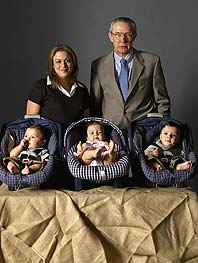
Patient: Roseann Errante, 36, mother-to-be
Doctors: Alan Monheit, obstetric surgeon, and Frank Seifert, heart surgeon, Stony Brook University Hospital
Patient’s husband: Joe Errante
Roseann: At 30 weeks I woke up with chest pains. It was like nothing I’d ever felt. The pains went up to my neck, ears, and head.
Monheit: I was on call when she came in. Her tests looked fine, but with the pain traveling to her neck, we called a cardiologist.
Joe: I was joking with the technicians that we were praying for preeclampsia—which is terrible. But at least we would’ve known what it was. They were looking at the scan and suddenly everyone stopped joking.
Seifert: She had aortic dissection, a tear in the inside wall of the aorta. The aorta is the largest blood vessel in the body. It starts at the heart and goes up to the great vessel, which supplies the brain, then loops around and goes down the back and supplies all the organs. Roseann’s dissection was in the part between the heart and the great vessel. Think of it as a run in a stocking. It could either stay where it was or just keep on going.

1. Conductor, 89, With Heart Problems, Too Old and Sick for Surgery2. Firefighter Separates Spine From Skull3. Taxi Driver Survives Testicular Cancer4. Baby With Severe Back and Rib Problems5. College Student Going Blind in Both Eyes6. Factory Worker Loses Hands7. Hockey-Mad 5-Year-Old Has Potentially Fatal Tumor8. Woman Carrying Triplets Has Torn Aorta9. Woman Needs Heart and Lung Transplant10. Hip-Replacement Complications May Cost a Woman Her Leg11. Four Siblings With Potentially Fatal Kidney Disease

Joe: There are a couple types of aortic dissection. She had the rarest, the horrible one.
Seifert: Roseann’s dissection had already gone down toward her heart. If the tear hit her coronary arteries, she’d have a heart attack, and if it hit the great vessel, she’d have a stroke. Or it could just break right through the aorta and she’d bleed to death.
Monheit: The death rate is 50 percent in the first 48 hours. She needed bypass surgery right away, but first we had to deliver the babies.
Joe: I tried to keep it together for her and her family, but as soon as they wheeled her in, I was a basket case. The worst-case scenarios just keep popping into your head.
Monheit: There were about 30 people in the room—my obstetrics team, Dr. Seifert’s team for the open-heart part, a team just for the bypass, and a neonatal doctor and nurse for each baby. There was so much equipment, we couldn’t fit it all in one room. We started the emergency C-section at 9:30 at night. We made the incision, cut into the uterus, and delivered the babies one by one.
Joe: Dr. Monheit came in and told us the babies were going upstairs for testing, and then the heart surgery was going to take five or six hours. I knew that if I saw Dr. Seifert before that, it would’ve been a horrible sign.
Seifert: As soon as Dr. Monheit closed her belly, we went in. First, we hooked up the heart-lung machine to arteries in her leg. Then we cooled the body. And at one point we stopped the heart for about an hour and a half so we had free time to work. Her aortic valve had collapsed, so we used stitches to bring it back up. Her aorta, where it had ripped, was the consistency of wet cardboard, so we had to replace that section, about four inches, with a plastic tube. At three o’clock in the morning I went to see Joe and said, “I think we look pretty good.”
Roseann: It was four days before I could see the babies. I went upstairs and named them: Samantha, Michael, and Joseph.
Joe: They were all small. Michael and Samantha came home at two months. Joseph was in the hospital for almost three months. His intestine burst, so he had to have two surgeries. The surgery survival rate is horrific for any baby under five pounds, but he’s twenty pounds now.
Roseann: They’re just the happiest babies. The two boys especially, all you have to do is put your hand on their necks and all of a sudden there’s this hearty laugh. Anthony is a great big brother, too. He sings for them, he dances, he takes care of their bottles. Trying to feed three 9-month-olds at the same time is a logistical nightmare, but for every moment that you’re frustrated or tired, there are five that make you smile. Next: Woman Needs Rare Heart and Lung Transplant